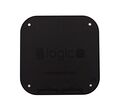Difference between revisions of "Saleae Logic16"
Uwe Hermann (talk | contribs) m (→Hardware) |
Uwe Hermann (talk | contribs) m (→Photos) |
||
| Line 210: | Line 210: | ||
File:Saleae Logic16 PCB top.jpg|<small>PCB, top</small> | File:Saleae Logic16 PCB top.jpg|<small>PCB, top</small> | ||
File:Saleae Logic16 PCB bottom.jpg|<small>PCB, bottom</small> | File:Saleae Logic16 PCB bottom.jpg|<small>PCB, bottom</small> | ||
File:Saleae logic16 xilinx xc3s200a.jpg|<small>Xilinx XC3S200A</small> | |||
File:Saleae logic16 cypress fx2lp.jpg|<small>Cypress FX2LP</small> | |||
File:Saleae logic16 eeprom b2th.jpg|<small>I2C EEPROM</small> | |||
File:Saleae logic16 dl46.jpg|<small>ST DVIULC6-4SC6</small> | |||
File:Saleae logic16 189z 189c.jpg|<small>Voltage regulators</small> | |||
File:Saleae logic16 72y7.jpg|<small>72Y7</small> | |||
</gallery> | </gallery> | ||
Revision as of 17:01, 3 August 2013
 | |
| Status | planned |
|---|---|
| Channels | 2/4/8/16 |
| Samplerate | 100/50/25/12.5MHz |
| Samplerate (state) | — |
| Triggers | none (SW-only) |
| Min/max voltage | -0.9V — 6V |
| Threshold voltage |
configurable: for 1.8V to 3.6V systems: VIH=1.4V, VIL=0.7V for 5V systems: VIH=3.6V, VIL=1.4V |
| Memory | none |
| Compression | yes |
| Website | saleae.com |
The Saleae Logic16 is a USB-based, 16-channel logic analyzer with 100/50/25/12.5MHz sampling rate (at 2/4/8/16 enabled channels).
The case requires a Torx T5 screwdriver to open.
See Saleae Logic16/Info for more details (such as lsusb -vvv output) about the device.
See Saleae Logic for the predecessor product of the Saleae Logic16.
Hardware
- FPGA: Xilinx Spartan-3A XC3S200A, 200K gates (datasheeet)
- USB interface chip: Cypress CY7C68013A-56PVXC (FX2LP) (datasheet)
- Ultralow capacitance ESD protection: 4x ST DVIULC6-4SC6 (datasheet)
- I2C EEPROM: Unknown. Marking: "B2TH".
- ?: 2x Unknown 5-pin IC. Markings: "189Z" and "189C".
- ?: 2x Unknown 3-pin IC. Markings: "72Y7".
Pinouts and connections:
JTAG header (FPGA):
The J3 pin header is a JTAG connector wired to the FPGA. The pins are (from left to right, the right-most pin is square):
| 1 | 2 | 3 | 4 | 5 |
|---|---|---|---|---|
| GND | TMS | TCK | TDO | TDI |
Testpoints:
| T1 | T2 | T3 |
|---|---|---|
| 1.2V | 3.3V | GND (FX2) |
Cypress FX2:
| 1 | 2 | 3 | 4 | 5 | 6 | 7 | 8 | 9 | 10 | 11 | 12 | 13 | 14 |
|---|---|---|---|---|---|---|---|---|---|---|---|---|---|
| PD5 (FPGA 15, IO_L05P_3) | PD6 (FPGA 13, IO_L04N_3) | PD7 (FPGA 10, IO_L03N_3) | GND | CLKOUT (FPGA 90, IO_0) | VCC | GND | RDY0/*SLRD (FPGA 3, IO_L01P_3) | RDY1/*SLWR (FPGA 3, IO_L01P_3) | AVCC | XTALOUT | XTALIN | AGND | AVCC |
| 15 | 16 | 17 | 18 | 19 | 20 | 21 | 22 | 23 | 24 | 25 | 26 | 27 | 28 |
| DPLUS | DMINUS | AGND | VCC | GND | *IFCLK (FPGA 84, IO_L02N_0) | RESERVED | SCL (EEPROM SCL) | SDA (EEPROM SDA) | VCC | PB0 (FPGA 40, IO_L08P_2) | PB1 (FPGA 78, IO_L01N_0) | PB2 (FPGA 77, IO_L01P_0) | PB3 (FPGA 50, IO_L11P_2) |
| 29 | 30 | 31 | 32 | 33 | 34 | 35 | 36 | 37 | 38 | 39 | 40 | 41 | 42 |
| PB4 (FPGA 46, MOSI) | PB5 (FPGA 41, IO_L08N_2) | PB6 (FPGA 37, IO_L07N_2) | PB7 (FPGA 93, IO_L05P_0) | GND | VCC | GND | CTL0 (FPGA 94, IO_L05N_0) | CTL1 (FPGA 97, IP_0) | CTL2 (FPGA 100, PROG_B) | VCC | PA0 (FPGA 54, DONE) | PA1 (FPGA 48, INIT_B) | PA2 (FPGA 53, CCLK) |
| 43 | 44 | 45 | 46 | 47 | 48 | 49 | 50 | 51 | 52 | 53 | 54 | 55 | 56 |
| PA3 (FPGA 51, MISO) | PA4 (FPGA 98, IO_L06P_0) | PA5 (FPGA 85, IO_L03P_0) | PA6 (FPGA 30, IO_L04P_2) | PA7 (FPGA 9, IO_L03P_3) | GND | RESET# (3.3V via D2 (diode?)) | VCC | *WAKEUP (3.3V) | PD0 (FPGA 6, IO_L02N_3) | PD1 (FPGA 4, IO_L01N_3) | PD2 (FPGA 5, IO_L02P_3) | PD3 (FPGA 44, IO_L09N_2) | PD4 (FPGA 12, IO_L04P_3) |
Photos
Firmware
The firmware for the FX2LP is embedded in the vendor application as a set of Intel HEX lines. Each line is uploaded individually with a separate control transfer. The firmware currently occupies the address range [0x0000-0x145d], but is uploaded out of order. TODO: Make a tool to extract the firmware from the application binary.
See Saleae Logic16/Firmware for more details on the vendor firmware.
Protocol
Sample format:
The samples (as received via USB) for the enabled probes (3, 6, 9, or 16) are organized as follows:
0xLL 0xLL 0xMM 0xMM 0xNN 0xNN 0xPP 0xPP 0xQQ 0xQQ 0xRR 0xRR ...
In the above example, 3 probes are enabled. For each probe there are 2 bytes / 16 bits (e.g. 0xLL 0xLL for probe 0), then the next probe's data is received (0xMM 0xMM for probe 1), then 0xNN 0xNN for probe 2. When 2 bytes have been received for all enabled probes, the process restarts with probe 0 again.
The 16 bits of data per probe seem to contain the pin state of the respective probe (1: high, 0: low) at 16 different sampling points/times (which ones depends on the samplerate).
Configuration:
Endpoint 1 is used for configuration of the analyzer. The transfers are "encrypted" using a simple series of additions and XORs. Two kinds of transfers are used; a 3 byte out transfer starting with 0x81 followed by a 1 byte in transfer, and a 4 byte out transfer starting with 0x80. It's quite plausible that these provide raw read/write access to memory locations.
| Channel number configuration | |
|---|---|
| 3 channels | 0x80 0x01 0x02 0x07 0x80 0x01 0x03 0x00 |
| 6 channels | 0x80 0x01 0x02 0x3f 0x80 0x01 0x03 0x00 |
| 9 channels | 0x80 0x01 0x02 0xff 0x80 0x01 0x03 0x01 |
| 16 channels | 0x80 0x01 0x02 0xff 0x80 0x01 0x03 0xff |
| Sampling frequency | |
|---|---|
| 500 kHz | 0x80 0x01 0x0a 0x00 0x80 0x01 0x04 0xc7 |
| 1 MHz | 0x80 0x01 0x0a 0x00 0x80 0x01 0x04 0x63 |
| 2 MHz | 0x80 0x01 0x0a 0x00 0x80 0x01 0x04 0x31 |
| 4 MHz | 0x80 0x01 0x0a 0x00 0x80 0x01 0x04 0x18 |
| 5 MHz | 0x80 0x01 0x0a 0x00 0x80 0x01 0x04 0x13 |
| 8 MHz | 0x80 0x01 0x0a 0x01 0x80 0x01 0x04 0x13 |
| 10 MHz | 0x80 0x01 0x0a 0x00 0x80 0x01 0x04 0x09 |
| 12.5 MHz | 0x80 0x01 0x0a 0x00 0x80 0x01 0x04 0x07 |
| 16 MHz | 0x80 0x01 0x0a 0x01 0x80 0x01 0x04 0x09 |
| 25 MHz | 0x80 0x01 0x0a 0x00 0x80 0x01 0x04 0x03 |
| 32 MHz | 0x80 0x01 0x0a 0x01 0x80 0x01 0x04 0x04 |
| 40 MHz | 0x80 0x01 0x0a 0x01 0x80 0x01 0x04 0x03 |
| 50 MHz | 0x80 0x01 0x0a 0x00 0x80 0x01 0x04 0x01 |
| 80 MHz | 0x80 0x01 0x0a 0x01 0x80 0x01 0x04 0x01 |
| 100 MHz | 0x80 0x01 0x0a 0x00 0x80 0x01 0x04 0x00 |









